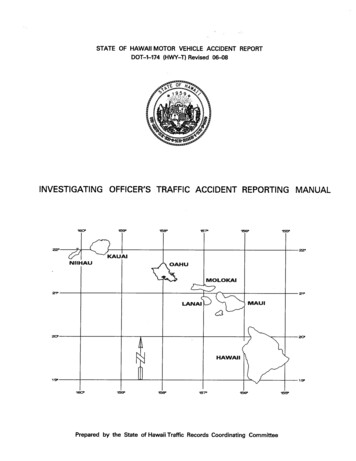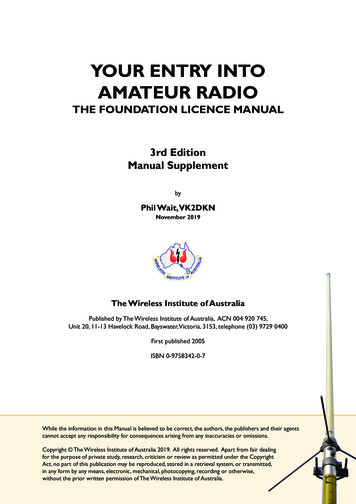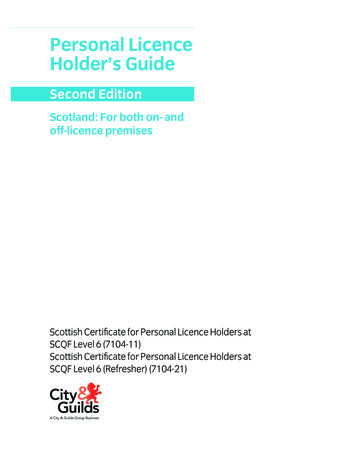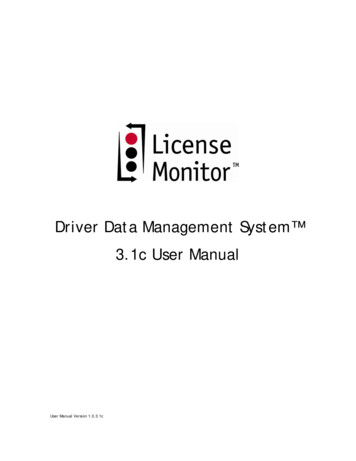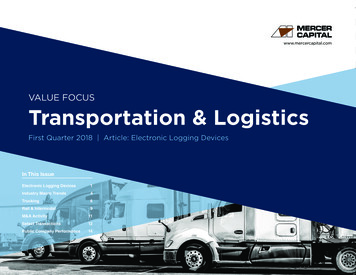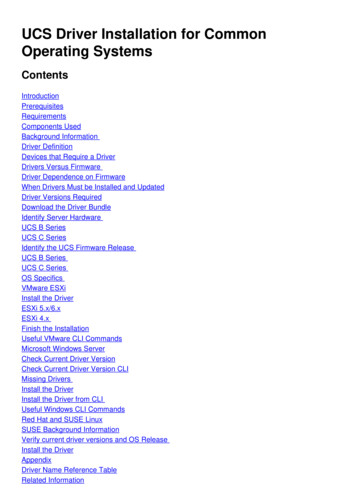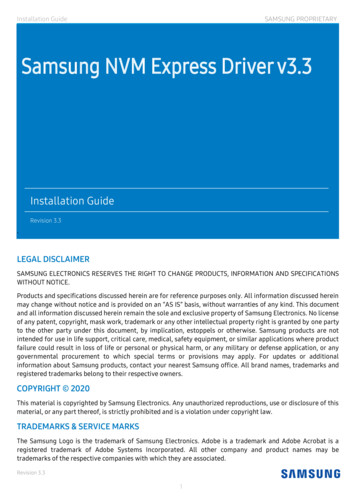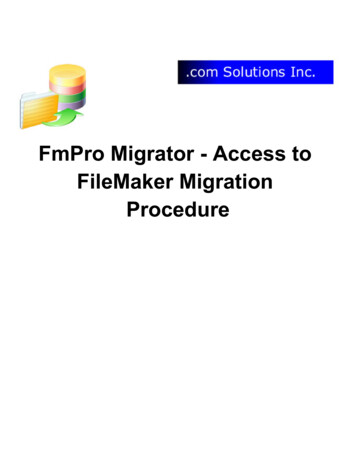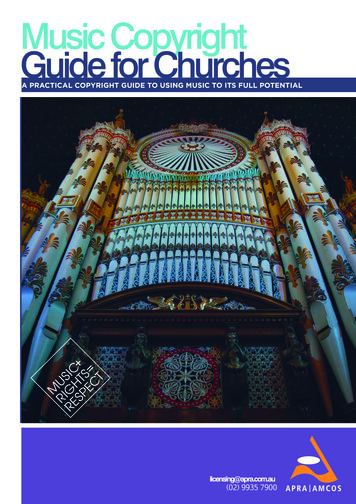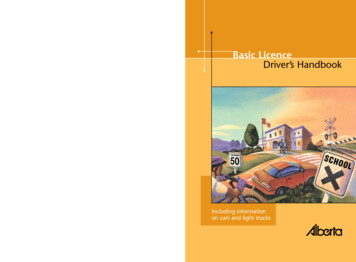
Transcription
Basic LicenceDriver’s HandbookFebruary 2009Alberta Basic Licence Driver’s HandbookIncluding informationon cars and light truckswww.saferoads.com
Table ofContentsChapter 2 Traffic ControlsSign shapes and colours . . . . . . . . . . 26Regulatory signs . . . . . . . . . . . . . . . . 27Speed limits . . . . . . . . . . . . . . . . . . . 28Chapter 1 Licence ClassificationsDesignated lane signs . . . . . . . . . . . . 28Graduated Driver Licensing . . . . . . . . 6Permissive signs . . . . . . . . . . . . . . . . 29Licence classifications . . . . . . . . . . . . . 8Prohibitive signs . . . . . . . . . . . . . . . . 30Photo identification card . . . . . . . . . . 8Crossing signs . . . . . . . . . . . . . . . . . . 31Class 7 . . . . . . . . . . . . . . . . . . . . . . . . 8Warning signs . . . . . . . . . . . . . . . . . . 31Class 6 . . . . . . . . . . . . . . . . . . . . . . . . 9Information and guide signs . . . . . . . 35Class 5 . . . . . . . . . . . . . . . . . . . . . . . . 9Road construction . . . . . . . . . . . . . . 36Class 4 . . . . . . . . . . . . . . . . . . . . . . . 10School zone signs . . . . . . . . . . . . . . . 38Class 3 . . . . . . . . . . . . . . . . . . . . . . . 11Playground zones . . . . . . . . . . . . . . . 39Class 2 . . . . . . . . . . . . . . . . . . . . . . . 12Traffic control signals . . . . . . . . . . . . 40Class 1 . . . . . . . . . . . . . . . . . . . . . . . 12Pedestrian signal lights . . . . . . . . . . . 44Learning requirements - All classes . . 13Lane control signals . . . . . . . . . . . . . 44Definitions . . . . . . . . . . . . . . . . . . . . 13Pavement markings . . . . . . . . . . . . . 46Applying for your licence . . . . . . . . . 16Parental consent requirement . . . . . . 16Chapter 3 Starting Your VehicleNon-Alberta licences . . . . . . . . . . . . . 17Starting your vehicle . . . . . . . . . . . . . 52New residents . . . . . . . . . . . . . . . . . . 17Steering . . . . . . . . . . . . . . . . . . . . . . 56International licence . . . . . . . . . . . . . 17Accelerating . . . . . . . . . . . . . . . . . . . 56Student . . . . . . . . . . . . . . . . . . . . . . 17Stopping . . . . . . . . . . . . . . . . . . . . . 57Vision screening . . . . . . . . . . . . . . . . 18Braking techniques . . . . . . . . . . . . . . 58Medical requirements . . . . . . . . . . . . 18Reversing (backing) . . . . . . . . . . . . . 59Condition codes . . . . . . . . . . . . . . . . 19Parking . . . . . . . . . . . . . . . . . . . . . . . 60Knowledge test . . . . . . . . . . . . . . . . . 19Parallel parking . . . . . . . . . . . . . . . . . 60Road test . . . . . . . . . . . . . . . . . . . . . 19Angle parking . . . . . . . . . . . . . . . . . . 63Upgrading your licence . . . . . . . . . . 21Hill parking . . . . . . . . . . . . . . . . . . . . 65Licences: duplicate/renewal/changes . . . . . . . . . . . . . . . . . . .22Registration and insurance . . . . . . . . 22
Chapter 4 Intersections and TurnsStop signs . . . . . . . . . . . . . . . . . . . . . 70Intersections controlled byyield signs . . . . . . . . . . . . . . . . . . . 71When you are involved ina collision . . . . . . . . . . . . . . . . . . 106Emergency vehiclesand tow trucks . . . . . . . . . . . . . . 107Right-of-way . . . . . . . . . . . . . . . . . . . 72Traffic circle . . . . . . . . . . . . . . . . . . . 72Chapter 7 The Responsible DriverControlled intersections . . . . . . . . . . 73Defensive driving . . . . . . . . . . . . . . 110Uncontrolled intersections . . . . . . . . 73Following distance . . . . . . . . . . . . . 112Signaling . . . . . . . . . . . . . . . . . . . . . 75Fatigue . . . . . . . . . . . . . . . . . . . . . . 113Turning . . . . . . . . . . . . . . . . . . . . . . . 76Cellular telephone use in vehicles . . 114Right turns . . . . . . . . . . . . . . . . . . . . 77Child restraints . . . . . . . . . . . . . . . . 114Left turns . . . . . . . . . . . . . . . . . . . . . 78Ways to improve fuel efficiency . . . 116Turning lanes . . . . . . . . . . . . . . . . . . 80Traffic laws . . . . . . . . . . . . . . . . . . . 119U-turns . . . . . . . . . . . . . . . . . . . . . . . 81Chapter 8 Sharing The RoadChapter 5 Lane DrivingPedestrian safety . . . . . . . . . . . . . . . 122Lane position . . . . . . . . . . . . . . . . . . 84Bicycle operators/cyclists . . . . . . . . 123Blind spots . . . . . . . . . . . . . . . . . . . . 85Motorcycle drivers . . . . . . . . . . . . . 125Passing lanes . . . . . . . . . . . . . . . . . . 86Off-highway vehicles . . . . . . . . . . . 126Merging . . . . . . . . . . . . . . . . . . . . . . 89Large vehicles . . . . . . . . . . . . . . . . . 126Exiting . . . . . . . . . . . . . . . . . . . . . . . 90School buses . . . . . . . . . . . . . . . . . . 127Weave zone . . . . . . . . . . . . . . . . . . . 91Emergency vehicles . . . . . . . . . . . . 129Curves and hills . . . . . . . . . . . . . . . . 91Snowplows . . . . . . . . . . . . . . . . . . . 130Maintenance vehicles . . . . . . . . . . . 130Chapter 6 Handling EmergencySituationsLog-haul vehicles . . . . . . . . . . . . . . 131Vehicle breakdown . . . . . . . . . . . . . . 94Light rail transit . . . . . . . . . . . . . . . 135Emergency braking . . . . . . . . . . . . . . 97Funeral processions and parades . . 136Railway crossings . . . . . . . . . . . . . . 132Skids . . . . . . . . . . . . . . . . . . . . . . . . . 98Off-road recovery . . . . . . . . . . . . . . . 100Chapter 9 Driving Within the LawNight and poor weather driving . . . 100Impaired driving and the law . . . . . 138Animals . . . . . . . . . . . . . . . . . . . . . 105
Alberta Administrative LicenceSuspensions . . . . . . . . . . . . . . . . 142Suspensions/disqualifications . . . . . 143Demerit point system,fully licenced drivers . . . . . . . . . . 146Demerit point schedule . . . . . . . . . 147Demerit point system for GDL . . . . 148Alberta TransportationSafety Board . . . . . . . . . . . . . . . . 150Chapter 10 Towing a TrailerTowing a trailer . . . . . . . . . . . . . . . 152
IntroductionA Message From Alberta TransportationWhen you put yourself in the driver’s seat, it can open up a whole newworld. Driving gives you the freedom to get around, but it also involvescertain risks. To avoid these risks you need to learn the following: Knowledge – the laws and rules of the road Skills – how to drive and handle a motor vehicle Proper attitude – how to behave when you are behind the wheelIt takes study and practice to obtain knowledge and skill. A person’s attitudetoward driving is more personal. It requires practice in much the samemanner as do skill and knowledge, but more than this; a person’s attitudecomes from within. You’re encouraged to drive safely and to develop yourknowledge and skills to a high degree. Be prepared to extend courtesy andpatience to other road users. Other drivers may not be as skillful or as smartas you. Always drive defensively so you won’t have to pay for someoneelse’s mistake.Alberta TransportationWeb Site: www.transportation.alberta.ca (under Drivers and Vehicles)Revised: February 20091
Alberta Transportation has three driver handbooks.1. Basic Licence Driver’s Handbook – Information For All ClassesThis handbook provides basic information for all drivers.2. Professional Driver’s HandbookThis handbook provides additional information about driving commercialvehicles and it is used with the Basic Driver’s Handbook for driving a truck,tractor-trailer, ambulance, taxi or bus.3. Motorcycle Operator's HandbookThis handbook provides additional information on the safe operation ofmotorcycles, mopeds or a power bike. It is used with the Basic Driver’sHandbook when you are learning to operate a motorcycle, moped or apower bike.These handbooks cover all classes of licenses available in Alberta. Theyprovide information to help you in obtaining an Alberta operator’slicence. We recommend that you consider professional driver training tosupplement your knowledge and skill. You may want to consider keepinga copy of a handbook in your vehicle as a reference.A workbook for coaching new drivers entitled Geared to Go is available freeof charge at registry agent offices.2
This handbook is a guide only and has no legislative sanction. The lawsapplicable to driving a vehicle can be found in the Traffic Safety Actavailable from:Queen’s Printer BookstorePark Plaza Building10611 – 98 Ave.Edmonton, Alberta, T5K 2P7Telephone: 780-427-4952Internet Site: www.qp.gov.ab.ca/catalogue/index.cfmMunicipalities are given authority under the Traffic Safety Act to pass bylawsin such areas as speed zones, school zones, playground zones and parking.A driver must be aware of local municipal by-laws.Motor vehicle registry informationService Alberta is responsible for the motor vehicle registry and theassociated services provided through the registry agent network. Motorvehicles services include driver and vehicle licensing, motor vehicle searches,driver's abstracts, driver testing, some suspension services, payment of fines,personalized plate application and many more.Registry agent locationsPlease refer to your local telephone SuperPages under Licence and RegistryServices or check out this web site http://www.servicealberta.gov.ab.ca/ra/ran.cfmFor driver and vehicle licensing information contact: Edmonton 780-427‑7013If you require further information regarding driver training schools or thedriver examination process, please contact Alberta Transportation, DriverPrograms Administrator at: Edmonton 780-427-8901You can access Alberta Government offices toll-free from anywhere in theprovince by first calling 310-0000.3
4
1Chapter 1Information about Operator’s LicencesLicence Classifications
1Information About Operator’s LicencesGraduated Driver LicensingGraduated Driver Licensing (GDL) is a program that will ensure new drivers,regardless of age, get the support, skills and experience they need tohandle the complex task of driving. Graduated Driver Licensing will improveroad safety by creating a lower risk and a more controlled environment forall new drivers. Practice and driver experience is what makes safe drivers.The following information highlights the key ingredients of GDL:Stage one learner (Class 7)To obtain a Learner’s licence you must: be 14 years of age or older pass a vision screening and a knowledge test on the rules of the road have parental consent if you are under 18 years of age valid identification (see page 16)Learner’s conditions Must hold a Learner’s licence (Class 7) for at least one year. Must be accompanied by a fully licensed (non-GDL probationary) driverwho is 18 years of age or older and is seated next to the driver. Not permitted to drive from midnight to 5 a.m. Not permitted to have more passengers than seat belts. They will be suspended at 8 demerit points than fully licensed drivers at 15. Have a zero alcohol level. If learning to drive a motorcycle, you must be 16 years of age and are notpermitted to drive during nighttime hours. You must be accompanied bya fully licenced (non-GDL probationary) driver who is 18 years of age orolder and is either seated on the motorcycle with you or is following youin or on another motor vehicle.Note: Operators of a moped with a Class 7 licence are subject to the zero alcohol levelrestrictions and are not permitted to drive during nighttime hours.6
1Stage two GDL probationary (Class 5)To become a probationary driver you must: Be 16 years of age or older. Pass the standard Alberta Class 5 road test.Probationary conditions Must spend a minimum of two years as a probationary driver. No more passengers than seat belts. They will be suspended at 8 demerit points than fully licensed drivers at 15. Have a zero alcohol level. No upgrading to a commercial licence (Classes 1, 2, 3 or 4). Cannot serve as an accompanying driver to a learner.Non-probationary licence (Class 5)To become a fully licensed driver you must: Have been suspension free for the last year of the two-year probationarystage. Pass an advanced road test.It will take a minimum of three years to complete both the learners andprobationary stages of Graduated Driver Licensing. It will take four yearsif you get your Learner’s licence at 14 years of age.If you apply for a Motorcycle Licence (Class 6) after your Class 7 licence, youare subject to the same conditions of the Graduated Driver Licensing Program.Advanced road testNew drivers will be required to show that they have mastered the skills toobtain a full-privilege operator’s licence. To obtain detailed informationabout this road test, visit our web site at:www.transportation.alberta.ca/543.htm7
1Licence classificationsPhoto identification cardThe minimum age for getting a photo identification card is 12 years. Thiscard can be issued to anyone who does not qualify for, or wish to get anoperator’s licence. The card does not permit anyone to drive or learn todrive any type of motor vehicle.To apply for a photo identification card you must: provide acceptable identification be an Alberta resident have written consent from a parent or guardian if you are under18 years of ageThe photo identification card must be returned when you get an operator’slicence.Class 7A person 14 years of age or older, may apply for a Learners Operator’sLicence. A parent or guardian must give consent on the application if theperson applying is under 18 years of age.The holder of a Class 7 operator’s licence may operate the following: a vehicle or combination of vehicles that the holder of a Class 5 operator’slicence may operate as a learner a motorcycle (for learning) if the holder of the licence is 16 years of ageor older a moped8
1Class 6The minimum learning or licensing age is 16 years of age.The holder of a Class 6 operator’s licence may operate the following: a motorcycle a mopedA Class 6 licence also allows you to drive as a learner in the motor vehicleslisted under the Class 5 category.A motorcycle must be provided for a Class 6 road test.Class 5The minimum learning age is 14 years and the minimum licensing age is16 years. Anyone applying for a licence under the age of 18 years musthave parental or guardian consent.The holder of a Class 5 operator’s licence may operate the following: a two-axle single motor vehicle a recreational vehicle with not more than three-axles a two-axle motor vehicle or a two-axle recreational vehicle towing a trailerwith one or more axles, if the trailer is not equipped with air brakes a three-axle recreational vehicle and a trailer if the trailer has not morethan two-axles and is not equipped with air brakes a moped all motor vehicles included under Classes 1, 2, 3 and 4 for learning onlyand the learner is at least 18 years of age a two-axle Class 2 or 4-type vehicle without passengers a motorcycle for learning onlyNote: Drivers of single-motor vehicles registered as farm vehicles do not require an air brake“Q” endorsement.The holder of a Class 5 operator’s licence shall not operate: a motorcycle9
1 a motor vehicle with a seating capacity of more than 15 while thatvehicle is transporting any person other than the driver a motor vehicle transporting passengers for hire a motor vehicle equipped with air brakes, unless the operator has an airbrake endorsement.Note: Drivers of single-motor vehicles registered as farm vehicles do not require an air brake“Q” endorsement.You must provide a two-axle motor vehicle, excluding a motorcycle, for theroad test. If the vehicle provided for the road test is equipped with air brakes,you must have either an air brake “Q” endorsement or a course completioncertificate from an approved air brake course. The exception would be twoaxle air brake equipped vehicles registered in Alberta as farm vehicles.Note: For hire with respect to a vehicle, means that the vehicle owner or operator, or theoperator’s employer, is being paid for the service that the vehicle is being used to provide,but for the purposes of sections 23 (Class 3 licence) and 25 (Class 5 licence), a motor vehicleis not for hire when the operator drives a private passenger vehicle for the transportation ofpassengers on an incidental or occasional basis and receives compensation in respect of thetransportation of those passengers only in one or more of the following forms:1. as payment for the kilometres travelled at a rate not exceeding the limit of tax-exemptallowance paid by employers to employees as prescribed in section 7306 of the Income TaxRegulations of Canada (CRC chapter 945);2. as straight reimbursement for out-of-pocket expenses directly related to the transportation,including, without limitation, gas, parking, gate passes and tolls;3. in a case where the operator is party to an agreement to provide transportation to onlythe operator’s family members, members of the operator’s household or persons for whom theoperator is a legal guardian, as compensation only to provide transportation to those persons.Class 4The minimum learning or licensing age is 18 years. You may not apply for aClass 4 operator’s licence as a probationary driver.The holder of a Class 4 operator’s licence may operate the following: any motor vehicle or combination of vehicles that the holder of a Class 510
1operator’s licence may operate a bus that has a seating capacity of not more than 24, excluding the operator an ambulance or taxi all motor vehicles under classes 1, 2, 3 and 6 for learning onlyYou must provide a Class 5 vehicle or a bus with a seating capacity notexceeding 24 passengers excluding the operator for a road test. An airbrake “Q” endorsement is required to operate air brake equipped vehicles.If the vehicle provided for the road test is equipped with air brakes, youmust have either an air brake “Q” endorsement or a course completioncertificate from an approved air brake course.Class 3The minimum learning or licensing age is 18 years. You may not apply for aClass 3 operator’s licence as a probationary driver.The holder of a Class 3 operator’s licence may operate the following: any motor vehicle or combination of vehicles that the holder of a Class 5operator’s licence may operate a single motor vehicle with three or more axles a single motor vehicle with three or more axles towing a trailer with oneor more axles, if the trailer is not equipped with air brakes Class 2 or 4 type vehicles without passengers all motor vehicles under Classes 1, 2 and 6 for learning onlyThe holder of a Class 3 operator's licence shall not operate a motor vehicle: that has a seating capacity of more than 15, while that vehicle istransporting any person other than the driver to transport passengers for hireYou must provide a single motor vehicle having three or more axles for theroad test. An air brake “Q” endorsement is required to operate air brakeequipped vehicles. If the vehicle provided for the road test is equipped withair brakes, you must have either an air brake “Q” endorsement or a course11
1completion certificate from an approved air brake course.Note: Drivers of single-motor vehicles registered as farm vehicles do not require an air brake“Q” endorsement.Class 2The minimum learning or licensing age is 18 years. You may not apply for aClass 2 operator’s licence as a probationary driver.The holder of a Class 2 operator’s licence may operate the following: a bus any motor vehicle or combination of vehicles that the holder of a Class 3,4 or 5 operator’s licence may operate Class 1 and 6 type vehicles for learning onlyYou must provide a bus with a seating capacity exceeding 24 passengersexcluding the operator for a road test. An air brake “Q” endorsement isrequired to operate air brake equipped vehicles. If the vehicle provided forthe road test is equipped with air brakes, you must have either an air brake“Q” endorsement or a course completion certificate from an approved airbrake course.Class 1The minimum learning or licensing age is 18 years. You may not apply for aClass 1 operator’s licence as a probationary driver.The holder of a Class 1 operator’s licence may operate the following: any motor vehicle or combination of vehicles other than a motorcycle Class 6 type vehicles for learning onlyYou must provide a tractor-trailer combination with three or more axles,equipped with air brakes for the road test. Proof of your air brake “Q”endorsement or a course completion certificate from an approved air brakecourse is required before a road test will be given. This also includes driversof farm vehicles registered as tractor-trailers.12
1Learning requirements – All classesDesiredLicenceClassClassNeeded mpaniedBy InstructorMinimumAge ForInstructorInstructorRequiresClassMinimumAge To TakeRoad Test12,3,4,5 or5-GDL*1818Yes18118non-GDL*23,4,5 or5-GDL*1818Yes181 or 218non-GDL*34,5 or5-GDL*1818Yes181,2 or 318non-GDL*43,5 or5-GDL*1818Yes181,2 or 418non-GDL*56 or 71614Yes181,2,3,4 or 51661,2,3,4,5or 71616Yes186161414Yes187Class being taught*GDL - Graduated Driver Licence (Probationary) Learning without an operator’s licence is not permitted. While learning in Classes 2 or 4, you are not permitted to carry passengers other than an instructor. Instructor must be a non (Graduated Driver Licence) probationary driver.DefinitionsAir brakes(air to all foundation brakes)An air brake vehicle is where the vehicle’s braking system is initiated by airpressure obtained from an engine-driven compressor and transmits thepressure through a series of hoses, reservoirs and control valves to all thevehicle’s foundation brakes. An air brake “Q” endorsement or Class 1 licenceis required.Air and hydraulic braking system(combination of air and hydraulic foundation brakes)An air over hydraulic braking system is where some of the vehicle’s axleshave air actuated foundation brakes and some of the vehicle’s axles havehydraulic foundation brakes. An air brake “Q” endorsement or Class 1 licenceis required.13
1Air actuated hydraulic braking system(air assisted, but all foundation brakes are hydraulic)An air actuated hydraulic braking system is where an air compressor is usedto boost the hydraulic system to all the vehicle’s foundation brakes. An airbrake “Q” endorsement is NOT required.Note: No person shall drive a vehicle equipped with air brakes (air to all foundation brakes)unless they hold either a Class 1 operator’s licence or an operator’s licence endorsed for airbrake operation.AmbulanceAn emergency vehicle that is designed for the transportation of injuredpersons and is equipped with rescue or first aid equipment.AxleMeans one or more shafts on which two or more wheels revolve.BusA motor vehicle that is: designed for carrying 11 or more persons, including the person drivingthe vehicle (TSA section 130(1)(i)) registered as a school bus. A school bus means a motor vehicle usedprimarily for transporting persons to and from a school registered as a commercial busHighwayA “highway” means any thoroughfare, street, road, trail, avenue, parkway,driveway, viaduct, lane, alley, square, bridge, causeway, trestleway or otherplace or any part of any of them, whether publicly or privately owned,that the public is ordinarily entitled or permitted to use for the passage orparking of vehicles and includes:(i) a sidewalk, including a boulevard adjacent to the sidewalk,(i) if a ditch lies adjacent to and parallel with the roadway, the ditch, and(ii) if a highway right of way is contained between fences or between afence and one side of the roadway, all the land between the fences,or all the land between the fence and the edge of the roadway, as the14
1case may be, but does not include a place declared by regulation not tobe a highway.Licenced driver examinerA person who conducts road tests on behalf of the Alberta government.These are private sector individuals trained, licenced, monitored andaudited by Alberta Transportation.Operator or driverA person who drives or is in actual physical control of a vehicle.Operator’s licenceA licence to operate a motor vehicle issued pursuant to the Traffic Safety Act.A person shall not drive a motor vehicle on a highway unless that person’soperator’s licence is in that person’s possession. On the request of a peaceofficer, a person driving a motor vehicle shall produce their subsistingoperator’s licence, insurance and registration. Ensure that these documentsare with you every time you operate a motor vehicle.“Q” EndorsementAn endorsement “Q” will be placed on any class operator’s licence, exceptClass 1, when a client successfully completes an approved Alberta air brakecourse through an authorized agency. Since a Class 1 licence may notbe obtained without the operator first having qualified for an air brakeendorsement, the actual “Q” endorsement will not appear on the Class1 licence. For information on taking an approved air brake course, pleasecontact a Driver Programs Administrator at:Edmonton 780-427-8901 or Calgary 403-297-6679.For toll free service from anywhere in Alberta, dial 310-0000.Note: Drivers of single-motor vehicles registered as farm vehicles do not require an air brake“Q” endorsement.15
1Recreational vehicleA motor vehicle designed or used for travel with temporary livingaccommodation for vacation or camping purposes.Applying for your licenceWhen applying for an Alberta operator’s licence you must have proof ofidentification. For information on the identification requirements, pleasecontact a registry agent or visit the Service Alberta web site at:www.servicealberta.gov.ab.ca(If under age of 18 years, please refer to the section on parental consentrequirement information below.)An operator’s licence may only be issued to residents of Alberta. A residentis a person lawfully entitled to be in Canada, who makes their home inAlberta and is ordinarily present in Alberta. Applicants originating fromoutside Canada or the United States must produce suitable immigrationdocuments to be considered as residents. Persons on student oremployment visas can apply as residents only for the time period specifiedon their visas.Parental consent requirementIf you are under the age of 18, and are making an operator’s licenceapplication for the first time, your parent or guardian, who must showproof of guardianship, must accompany you to a registry office to signconsent on your licence application.Remember a parent or guardian has the right to withdraw their consent inwriting at any time until the person reaches the age of 18 years. If they do,the operator’s licence will be suspended.The signature of your parent or guardian is not required if you can proveyou are married or self-supporting.16
1Non-Alberta licencesA person who is authorized to drive a motor vehicle of a particular class ortype under a valid licence or permit issued in a jurisdiction outside Alberta isnot required to hold a subsisting operator’s licence if the person drives thesame type or class of motor vehicle in Alberta.New residentsPeople who have recently moved into Alberta may use a valid operator’slicence from outside of Alberta for the first 90 days of their residency.You must apply for your Alberta operator’s licence and surrender yourold licence within those 90 days. It is illegal to hold more than one validoperator’s licence.An operator’s licence from another jurisdiction within Canada is accepted asthe same Class without testing. Applicants for Class 1, 2 or 4 licences mustprovide a medical report and undergo a vision screening. United States licenceholders other than those in Class 5, 6 and 7 must complete all requirements.Upon application, you may be required to provide documents to proveresidency. For details, inquire at your local registry agent’s office.International licenceA non-resident holding an International Operator’s Licence issued outside ofCanada, may use their licence to operate a particular class or type of motorvehicle. This only applies if the person operates the same type or class ofmotor vehicle in Alberta. They may use this licence for 12 months or until itexpires, whichever comes first.StudentA student is not required to obtain an Alberta operator’s licence whenoperating a motor vehicle if the following apply:17
1 The student is authorized to operate a motor vehicle of the same type orclass by the laws of the jurisdiction in which the student ordinarily resides. The documents req
This handbook provides basic information for all drivers . 2. Professional Driver’s Handbook This handbook provides additional information about driving commercial vehicles and it is used with the Basic Driver’s Handbook for driving a truck, tractor-trailer, a
